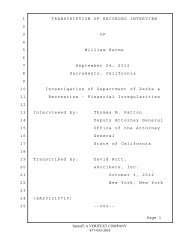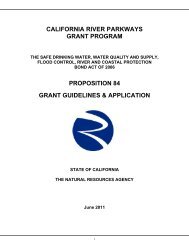California's Ocean Economy - California Resources Agency - State ...
California's Ocean Economy - California Resources Agency - State ...
California's Ocean Economy - California Resources Agency - State ...
Create successful ePaper yourself
Turn your PDF publications into a flip-book with our unique Google optimized e-Paper software.
NOEP<br />
ocean and economic activity, so a methodology has been devised that allows the data sets to<br />
be as compatible as possible with the realities of this particular slice of the economy; (2)<br />
other essential data are missing or irregularly available. Particularly, sector data at the county,<br />
and even regional level, in many cases cannot be publicly revealed because of federal rules of<br />
disclosure that protect proprietary information on firms; (3) standard economic data do not<br />
fully capture all of the economic value of the ocean. Recreational uses such as a day at the<br />
beach, or just enjoying a view of the sea do not appear in market data sets, but rather, are<br />
found in studies using a range of methodologies, and are thus not included in our estimates.<br />
1.3 Definitions and Terminology<br />
To avoid repetition and for clarification purposes, the following terms and definitions<br />
regarding economic indicators and valuation categories are found in the beginning of this<br />
report, so that the reader can fully understand what is intended.<br />
Coastal <strong>Economy</strong>: the sum of all economic activity occurring in counties defined as part of<br />
a state’s coastal zone management program, including four additional counties that are part<br />
of San Francisco Bay and the Sacramento River Delta areas. Most, but not all of the <strong>Ocean</strong><br />
<strong>Economy</strong> is part of the Coastal <strong>Economy</strong>.<br />
<strong>Ocean</strong> <strong>Economy</strong>: those activities that create goods and services, a portion of whose value<br />
is affected by the ocean and its resources. Economic statistics are grouped by a classification<br />
system known as the Standard Industrial Classification (SIC), which imperfectly reflects the<br />
relationship between economic activity and the ocean. 8 Only part of the Coastal <strong>Economy</strong> is<br />
part of the <strong>Ocean</strong> <strong>Economy</strong>.<br />
Dollar Values: expressed in constant 2000 dollars (adjusted by the Consumer Price Index).<br />
• Dollar values are estimated as direct and indirect values. Indirect values include induced<br />
values.<br />
• Direct values: those activities associated only with the designated ocean industries such<br />
as travel and tourism and living resources (examples include labor and capital costs<br />
associated with hotel accommodations or labor and capital costs for fish processing).<br />
• Multipliers: indirect and induced values. Multipliers affect the estimates of employment,<br />
wages, and output within the region. Indirect effects include both the change in<br />
economic activity in industries within the region that buy or sell from ocean industries<br />
(examples include sales of food to restaurants and hotels and the activities of travel<br />
agents booking trips) and the change in economic activity resulting from the spending of<br />
the wages earned by those employed by the ocean industries within the region. All<br />
indirect values or multiplier effects are based on IMPLAN, a standard and widely used<br />
economic impact model.<br />
8 After 2000, all industries are classified using the North American Industry Classification System (NAICS) rather than the<br />
Standard Industrial Classification (SIC by BLS). Both SIC and NAICS codes have been provided for 2001 as a benchmark<br />
leaving further calculations to the user. NAICS focuses on how products and services are created, as opposed to SIC which<br />
focuses on what is produced. Using NAICS yields significantly different industry groupings from those produced using SIC.<br />
These differences in NAICS and SIC structures, preclude direct comparison between NAICS data and SIC-based data for<br />
earlier years for historical series.<br />
7







